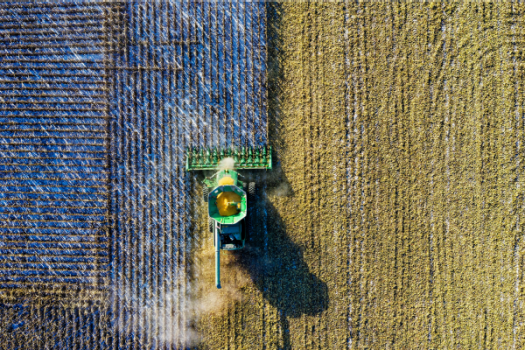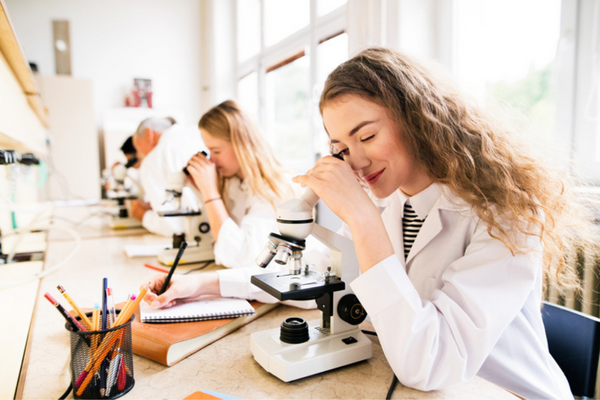
What technology trends are you following most closely, with an eye toward how they may impact the work of your scientists and Corteva’s future growth?
I’m keeping a close eye on artificial intelligence (AI), machine learning and automation – we’re at an interesting point in our industry where these technologies are beginning to make a huge impact. We’re seeing a digitalization of so much of what we do both within R&D and across many aspects of our business. While these technologies aren’t new, they’re already enabling us to accelerate R&D processes and make higher-quality, data-driven decisions much faster than ever before.
For example, using AI and machine learning, we’re able to analyze thousands of images to understand different views, how our molecules work, symptomology, and more. We can see how our active ingredients are making an impact on real challenges farmers face, like pests, weed pressure, soil health – even before the human eye can see it.
At the same time, farmers are embracing technology. As they become increasingly tech-savvy, they’re becoming more open to using AI, for example, to optimize what they do. Data about weather patterns, the best crop rotations, use of nitrogen, even when and how much to water to use are enabling farmers to be even more informed and make even more precise decisions to maximize yield. Ultimately, this helps put farmers in an even better position to pass their farms on to future generations.
What are the biggest challenges confronting farmers that the average person has little appreciation for?
We’re all fighting against a decrease in global food security. In fact, Economist Impact just published the tenth annual Global Food Security Index (GFSI), which provides a lookback over the past 10 years of data to help propel us toward the UN Sustainable Development Goal of reaching zero hunger by 2030. The report revealed a decline in global food security for the second consecutive year.
Farmers are on the front lines, faced with helping to figure out how to satisfy increased demands for more food across the globe. There’s mounting pressure to maximize yields without adverse environmental impact and without conversion of non-agricultural land. At the same time, farmers must navigate growing complexity stemming from climate change, pests, the distribution of disease, temperature stress on crops, and more. And they’re focused on protecting biodiversity while also ensuring they’re making decisions that enable them to pass farms down to future generations.
I don’t think the average person truly understands or appreciates the challenges of farming today: the decisions growers must make and the unforeseen shifts farmers have to anticipate and manage while ensuring they have the right tools and innovation to improve local productivity. It’s a tall order!
The Society of Asian Scientists and Engineers (SASE) awarded you its 2020 Distinguished Career Award winner. In doing so, it said you are “ … committed to building a diverse workforce and has engaged in targeted outreach to address under-representation.” What sort of efforts in this area have you undertaken that have yielded the greatest results?
As a company, we are committed to advancing inclusion, diversity, and equity. We firmly believe it’s the right thing to do for our people – and it’s the right thing to do from a business perspective too.
We are a company focused on innovation – and coming up with creative, new solutions to address the ever-evolving challenges farmers face requires a team of people from across the globe with diverse backgrounds, perspectives, and experiences. That diversity of thought coupled with scientific excellence is what it takes to deliver the impactful tools and technologies farmers need.
The composition of my own leadership team is reflective of this thinking – it’s a very diverse group. I have long believed diversity and the collaboration among an array of leaders within my organization are key drivers of our success and our industry-leading pipeline. We’re collaborating across borders every day with team members in China, India, Japan, Europe, Canada – every part of the world.
One example of work we’ve done recently is a program called Corteva Developing Emerging Leaders and Talent in Agriculture, or simply, “Corteva DELTA.” It was modeled after a similar program in place at one of our heritage companies. I had the privilege of helping develop that program and am pleased a talented team at Corteva put something similar in place.
The goal of Corteva DELTA is to enable STEM students with diverse backgrounds to apply their skills to a career in agriculture, share their interest and research, and gain insight into careers in the industry, sustainable and reliable food production, and Corteva. In our first year, 40 U.S.-based, under-represented minority undergraduate and graduate students, as well as postdocs, participated in a virtual symposium. We also awarded six undergraduate scholarships and 11 grants to graduate students and post-docs, which were accompanied by a Corteva mentor as part of the DELTA program.
This is just a small glimpse into the work we’re doing at Corteva in this arena. We believe in the power of diversity, an inclusive workforce, and a culture of belonging to enable us to deliver innovative products and solutions and best serve our global customer base. While Corteva has made inroads, there is more work to be done, and I am always thinking about new ways I can both mentor the internal talent that already exists on my team and attract even more diverse employees to our company.
Given the importance of food to human life, and the projections for population growth, do governments – generally speaking – invest appropriately in agricultural research?
This is a great question – and an important one. In my opinion, the answer is no.
Ending global hunger is one of the greatest challenges, and opportunities, of our lifetime. We live in the most abundant period in history, yet one in nine people do not have enough food to nourish their lives. According to the Food and Agriculture Organization (FAO), there are more than 820 million people who suffer from hunger around the world.
To advance food security, our global food system must navigate a myriad of hurdles, including:
- a future marked by climate change and declining natural resources,
- the need to access both adequate nutrition and adequate amounts of Calories,
- an under investment in agriculture,
- gaps in technology,
- regulations limiting producers’ ability to trade freely,
- consumers’ ability to access more affordable and nutritious food,
- and society’s ability to supply food to the places it is needed most.
And, while we have improved the production of crops and livestock over the years, trillions of pounds of food go to waste each year.
The world’s population is expected to grow from 7 billion today to 9 billion by 2050. To keep up with our growing population, global agriculture production must increase by more than 60%. At the same time, consumer expectations for safe, abundant, and nutritious food are echoing all the way though the food system, putting unique demands on farmers.
This challenge is big – and the kind that warrants additional funding into agricultural research.
Economist Impact’s GFSI weighs the affordability, availability, quality, and safety of food and assesses “how resilient nations are in protecting their natural resources to enable them to keep producing food now and in the future,” according to the report.
The report makes clear that government and non-governmental (NGO) support, including food safety net systems, as well as public/private partnerships, are crucial to building resilience. It says, “Investments are needed in research and innovation, preparations must be made to weather climate-related disasters, and natural resources need protection.”
The report also states, “Reduced public investment in agriculture R&D is a major contributor to poorer performance by high-income, top-performing countries.”
The time for additional investment in agriculture research is now – so that through new innovations, we can help solve the food system challenges we face now and in the future.
If you had to break it out in rough percentages, how much of your career success do you owe to (a) your formal academic schooling, (b) the professional training provided by your employer, and (c) general on-the-job experience?
I’d say it’s an even split. All three have helped me progress in my career. There is no doubt strong academics served as a springboard, first to getting my foot in the door early into my career and then moving into positions of increasing responsibility.
My professional training, along with more general on-the-job training, are equally important. Both fed my appetite to constantly learn and evolve, first as a scientist and, over time, as a leader. I’ve held roles in process research, regulatory, and discovery – all of which have enabled me to approach R&D with a focus on delivering products that help customers.
Today, I think of myself first and foremost as a scientist followed closely by a businessperson. I have a blend of a formal scientific education with business acumen built over the course of my career. While I’ve always had a bit of an entrepreneurial spirit, growing my business knowledge is the result of on-the-job learning. That’s also helped me recognize the importance of a strong connection between R&D and the business, their understanding of market needs, meeting our customer needs to drive yield and drive profitability. That’s one thing that sets Corteva a part in a highly competitive industry – we don’t just “do science to do science.” We’re always thinking about the innovations farmers really need – and our purpose, which is to enrich the lives of those who produce and those who consume, ensuring progress for generations to come. Our ability to deliver on that is a blend of modern science and alignment both with the customer and across our business.
What’s the most significant sustainability issue confronting your team? And what is your plan to address it?
Sustainability isn’t an issue – it’s how we do business. Corteva and its heritage companies have always supported sustainable farming, pushing past the boundaries of innovation by investing in agricultural research and technologies that improve productivity and enhance sustainability. We’re building on the sustainability legacy of our heritage companies and brands with a new vision for the future.
Every day, we’re taking on the challenges facing the global food supply by innovating, collaborating, and engaging. We’re growing sustainable solutions that protect the source of our food, help agricultural communities thrive, and provide tools for healthier lives. And we’ve established 14 goals focused on environmental, economic, and social sustainability that we are committed to achieving by 2030 to help increase the resilience of our global food system.
Like the farmers we serve, we care deeply for the health and wellbeing of our natural environment. So much so that teva, which means “everything nature” in Hebrew, is incorporated in our name. Sustainable performance is built into our design and discovery process from beginning to end.
As a six-time Green Chemistry Challenge Award winner, we’ve been recognized by the U.S. Environmental Protection Agency (EPA) more than any other agricultural input company for groundbreaking scientific solutions to real-world environmental problems.
We are leaders in utilizing predictive safety approaches within our industry to determine environmental impact earlier in the crop protection product development process. This enables us to incorporate environmental safety into the earliest stages of product design.
Our commitment to sustainability is in who we are and what we do. We are driving a more responsible food system, one that sustains and enriches our lives and our planet.
Talk about the metaphorical “one that got away”. Is there a project that eluded you? Why? And if you could return to it, what would you do differently?
There are many examples of this – it’s just the nature of what we do. As we research new or improved active ingredients, biologicals, formulations – there are almost always challenges, like toxicological issues in later stages. But we’re constantly learning something new and applying those learnings to develop new molecules and uncover additional discoveries in which we need to invest. At this point, we’ve institutionalized those learnings into other projects so we can come up with even better active ingredients.
We have one of the highest success rates in our pipeline compared with competitors. Part of that is the result of past learnings that we’ve applied to new projects. In addition, we formed a predictive safety center to determine environmental impact earlier in the crop protection product development process, enabling us to incorporate environmental safety into the earliest stages of product design.
Ten years from now, what advancement in crop protection will have the greatest impact on farmers?
I think the most impactful advancement will be a holistic solution that enables farmers to address the whole acre. While advancements in crop protection, traits, germplasm, biologicals, and digital tools will continue helping farmers address challenges, the biggest impact on driving yield, soil health and more will employ all these tools in one, harmonized solution.
If you think about it, it’s a lot like the mobile phones we all now carry around in our pockets. When mobile devices were first introduced, they were just used to make phone calls. Today, they’ve progressed into powerful computers that fit in the palm of our hands. The future of farming will follow that path, becoming a farming system that works cohesively. It will be another powerful example of the famous phrase coined by Aristotle, “The whole is greater than the sum of its parts.”
How has your family influenced your leadership style?
My parents owned their own business. That’s where I got my entrepreneurial spirit. I watched them work extremely hard every day, adjusting and taking risks to ensure the business remained successful. My drive to succeed came from seeing them push hard every day to take care of their customers and their employees.
I learned early in my life the importance of taking calculated risks – which has been instrumental in my career. I left India for the United States to attend graduate school. I really didn’t know anyone. Yet, I knew the decision was the right one because my parents raised me to understand that taking risks was critical. Moving to the U.S. by myself was the ultimate risk-taking lesson. And that decision continues to serve me well and helps to define how I lead.
I want my team to know that we have a “fail-fast and learn” environment – and my leadership style reflects that. It stems from my own experience feeling comfortable taking risks. In our business, we can’t be successful if we don’t take data-driven risks. The biggest risk for any R&D-centered company is not taking one. Every day at Corteva, we’re trying something new. We say we have an “owner mindset” at our company. Every employee owns a piece of our success. In R&D, we’re very deeply focused on science. At the same time, we must be strongly invested in and connected to the business and the why. We do what we do every day for our customers – the farmers – and the environment.
The most important component of my leadership style is the tone I set for my team. As a leader, I work hard to create a collaboration-centered culture. Across my team, and throughout all of R&D, we are constantly working together to ideate, problem solve, and uncover new approaches to solving farming challenges. In addition, work should be fun. It’s fun to solve problems that really matter and it's fun to build relationships with colleagues. I work hard to be a leader who engages with my employees on a personal level – I saw my parents do this with their employees and customers, getting to know them beyond just the job they did each day. Building relationships with colleagues and taking steps to help them see me as a person, not just their boss, is an important element of my leadership style.
What non-technical skills have you most relied on to-date for your career advancement?
Being communicative, humble, and a good storyteller are at the top of my list.
First, being communicative is critical and I rely on that skill every day. It’s all about listening first followed by open communication. Listening to employees – really listening – to make sure they have what they need and are continuing to thrive. Listening to famers – hearing the challenges they’re facing and the solutions they need to overcome them. This has always been front and center at Corteva because it is such a critical element to drive innovation. We don’t do science just to do science – it’s always focused on solving real problems for our farmers. I didn’t learn that from any of my professors – it came from my experience on the job. At the same time, it’s important to keep teams and customers informed about the work we’re doing to help farmers and move the agricultural industry forward.
Second, humility. I’m reminded of a Duke University study called, “Personality and Individual Differences.” The study found that some respondents were willing to adjust their opinions if new evidence suggested their view wasn’t accurate. The researchers considered those individuals as “intellectually humble.” In science, we challenge assumptions. We work to prove hypotheses. We use data to support or refute our initial thinking – and the willingness to adjust based on what we learn is critical.
Applying that same thinking to my career has helped shape the kind of colleague and leader I am. It guides how I mentor and develop my team. I’ve had many kinds of leaders in my career. Those that understand and prioritize helping others succeed are the ones after whom I have modeled my own leadership style.
Last, but certainly not least, throughout my career, I’ve relied upon an ability to tell compelling stories. It’s hard to think about the importance of storytelling in business without mentioning Simon Sinek, a British-American author and inspirational speaker, who said, “Stories are attempts to share our values and beliefs. Storytelling is worthwhile when it tells what we stand for.”
Whether I’m speaking at a conference, engaging with other scientists, farmers or leaders across our business, or even presenting to our board, stories help me connect to my audience and frame what I’m explaining with context that resonates across backgrounds and experience levels. The professors and business leaders that engaged my interests the most often started lectures or meetings with stories that brought students or colleagues together.
These three skills have proven invaluable to me throughout my career. Today, I’m fortunate to lead a large team of scientists who I believe are among the most skilled and talented in the industry. What drives and fulfills me is working alongside them, developing innovations that truly make a difference as we continue working collectively toward a common purpose. At Corteva, that’s to enrich the lives of those who produce and those who consume, ensuring progress for generations to come.
Having spent 30 years in the industry, can you share three essential things you learned on the job that professors didn’t teach you in university?
While my professors taught me a great deal in university, the actual hands-on experience I’ve gained while in industry has been invaluable. I’m fortunate that the list of things I’ve learned on-the-job is lengthy – with the three essential items including:
Working across a variety of scientific fields in R&D, including discovery research, process chemistry research, regulatory and, more recently, in the development space. The knowledge and experience I gained by working within each of those R&D disciplines gave me a more complete understanding of the function and that just cannot be replicated in classroom or academic lab setting.
Doing hypothesis-based, focused research on customer-driven needs. The ability to do modern science that’s directly connected to and solves real farmer challenges is incredibly rewarding. It’s also been a huge catalyst for me in drawing connections between the science, the purpose and the business.
Learning the importance of being agile, constantly adopting to change and building the resilience to pivot as needed. For example, like so many companies across the world, our team had to figure out how to adapt to the Covid pandemic. It changed the way we work but our priorities remained intact. As a science-based company with labs across the globe, safety always comes first. In the midst of a pandemic, that’s taken on an even higher level of criticality: keeping scientists safe while enabling them to continue innovating without close contact and managing the associated stress while balancing mental health and well-being.
What’s a place you can’t wait to go back to?
I love traveling anywhere and in non-pandemic times, I jump at the chance any time I can! The opportunity to experience different cultures, meet new people, try new foods and see amazing places is one of my favorite things to do. If I have to pick one place to go back to though, I’d have to say it would be returning home to India.

Vid Hegde, PhD, leads Crop Protection Discovery and Development within the R&D organization for Corteva Agriscience. In this role, he leads end-to-end programs to discover, develop, and deploy sustainable crop protection and biological products for the company’s Crop Protection Business Platform.
Vid launched his career as a scientist with Dow Chemical Company, where he contributed to developing pharmaceutical therapeutic products. Later, he joined Dow AgroSciences’ Process Research group to create scalable and economical routes for pipeline molecules. He subsequently held progressive leadership roles within Crop Protection Discovery and R&D. Vid earned his Ph.D. in organic chemistry from Temple University and completed his post-doctoral studies at the University of Houston. He holds 18 patents and has authored or co-authored more than 30 peer-reviewed articles and scientific presentations.
This article has been edited for length and clarity. The opinions expressed in this article are the author's own and do not necessarily reflect the view of their employer or the American Chemical Society.













